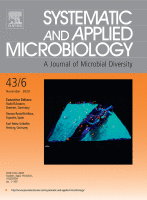Ver ítem
- xmlui.general.dspace_homeCentros e Institutos de InvestigaciónCICVyA. Centro de Investigación en Ciencias Veterinarias y AgronómicasInstituto de Microbiología y Zoología AgrícolaArtículos científicosxmlui.ArtifactBrowser.ItemViewer.trail
- Inicio
- Centros e Institutos de Investigación
- CICVyA. Centro de Investigación en Ciencias Veterinarias y Agronómicas
- Instituto de Microbiología y Zoología Agrícola
- Artículos científicos
- Ver ítem
Signs of a phyllospheric lifestyle in the genome of the stress-tolerant strain Azospirillum brasilense Az19
Resumen
Azospirillum brasilense Az19 is a plant-beneficial bacterium capable of protecting plants from the negative effects of drought. The objective of this study was to determine and analyze the genomic sequence of strain Az19 as a means of identifying putative stress-adaptation mechanisms. A high-quality draft genome of ca. 7 Mb with a predicted coding potential of 6710 genes was obtained. Phylogenomic analyses confirmed that Az19 belongs to the brasilense
[ver mas...]
Azospirillum brasilense Az19 is a plant-beneficial bacterium capable of protecting plants from the negative effects of drought. The objective of this study was to determine and analyze the genomic sequence of strain Az19 as a means of identifying putative stress-adaptation mechanisms. A high-quality draft genome of ca. 7 Mb with a predicted coding potential of 6710 genes was obtained. Phylogenomic analyses confirmed that Az19 belongs to the brasilense clade and is closely related to strains Az39 and REC3. Functional genomics revealed that the denitrification pathway of Az19 is incomplete, which was in agreement with a reduced growth on nitrate under low O2 concentrations. Putative genes of the general stress response and oxidative stress-tolerance, as well as synthesis of exopolysaccharides, carotenoids, polyamines and several osmolytes, were detected. An additional poly-beta-hydroxybutyrate (PHB) synthase coding gene was found in Az19 genome, but the accumulation of PHB did not increase under salinity. The detection of exclusive genes related to DNA repair led to discover that strain Az19 also has improved UV-tolerance, both in vitro and in planta. Finally, the analysis revealed the presence of multiple kaiC-like genes, which could be involved in stress-tolerance and, possibly, light responsiveness. Although A. brasilense has been a model for the study of beneficial plant-associated rhizobacteria, the evidence collected in this current study suggests, for the first time in this bacterial group, an unexpected possibility of adaptation to the phyllosphere.
[Cerrar]

Fuente
Systematic and applied microbiology 43 (6) : 126130. (Noviembre 2020)
Fecha
2020-11
Editorial
Elsevier
ISSN
0723-2020
1618-0984
1618-0984
Documentos Relacionados
Formato
pdf
Tipo de documento
artículo
Proyectos
(ver más)
INTA/2019-PD-E4-I069-001/2019-PD-E4-I069-001/AR./Bioprospección y caracterización de microorganismos benéficos para la protección y producción vegetal
INTA/2019-PD-E2-I037-002/2019-PD-E2-I037-002/AR./Biodiversidad edáfica: componente clave para una gestión integral y sustentable del recurso suelo
Palabras Claves
Derechos de acceso
Restringido
 Excepto donde se diga explicitamente, este item se publica bajo la siguiente descripción: Creative Commons Attribution-NonCommercial-ShareAlike 2.5 Unported (CC BY-NC-SA 2.5)
Excepto donde se diga explicitamente, este item se publica bajo la siguiente descripción: Creative Commons Attribution-NonCommercial-ShareAlike 2.5 Unported (CC BY-NC-SA 2.5)

